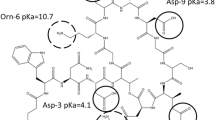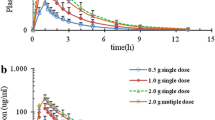Summary
Ten patients about to undergo a colorectal operation lasting an average of three hours received 500 mg each of imipenem and cilastatin i.v. preoperatively. During the operation blood and tissue samples were taken in order to determine the serum kinetics of the substances as well as the levels of imipenem in the cutis, subcutis, fascia, muscle, parietal peritoneum and colon. The imipenem concentrations were measured by HPLC. The mean peak serum concentration was 26 mg/l, the mean half-life 55 min and the AUC 40 mg/l/h−1. The serum pharmacokinetics of imipenem was subject to substantially larger fluctuations in this patient group than in subjects or patients without surgery. Imipenem rapidly penetrates into tissue, with peak concentrations being reached after 10–25 min. The highest imipenem concentrations were found in the colon, the lowest in the cutis and subcutis. After 1 h a level of 8 mg/kg imipenem was still found in the colon. The concentrations were > 1 mg/kg in all tissues for more than 3 h p. a. and thus within this period exceeded the MICs ofEscherichia coli andBacteriodes fragilis, the indicator organisms of intraabdominal infections.
Zusammenfassung
Zehn Patienten, die sich einer kolorektalen Operation von durchschnittlich drei Stunden Länge unterziehen mußten, erhielten präoperativ je 500 mg Imipenem und Cilastatin i.v. Während der Operation wurden Blut und Gewebeproben für eine Serumpharmakokinetik sowie zur Bestimmung der Konzentrationen von Imipenem in der Kutis, Subkutis, Faszie, im Muskel, im Peritoneum parietale und Dickdarm entnommen. Die Imipenem-Konzentrationen wurden mit der HPLC-Methodik bestimmt. Die durchschnittliche Serumspitzenkonzentration lag bei 26 mg/l, die mittlere Halbwertszeit bei 55 min und die AUC bei 40 mg/l/h−1. Die Serumpharmakokinetik von Imipenem unterlag bei dieser Patientengruppe wesentlich größeren Schwankungen als bei Probanden oder Patienten ohne Operation. Imipenem penetriert schnell in das Gewebe. Nach 10–25 min wurden die höchsten Konzentrationen gemessen. Der Dickdarm weist die höchsten, Kutis und Subkutis die niedrigsten Imipenem-Konzentrationen auf. Im Dickdarm sind nach einer Stunde noch 8 mg/kg Imipenem nachzuweisen. In allen Geweben lagen die Konzentrationen mehr als drei Stunden p. a.=1 mg/kg und damit über diesen Zeitraum höher als die MHK-Werte vonEscherichia coli undBacteroides fragilis, den Leitkeimen bei intraabdominellen Infektionen.
Similar content being viewed by others
References
Erttmann, M., Tiede, A., Jostarndt, L., Vestweber, K. H., Ullmann, U., Hamelmann, H.: Voraussetzungen und Durchführung einer perioperativen Antibiotikaprophylaxe am Beispiel kolorektaler Operationen.Thiede, A., Jostarndt, L., Hamelmann, H., Aktuelles zur Rektumchirurgie. Springer Verlag, (1985) pp. 97–116.
Kropp, H., Gerckens, L., Sundelof, J. G., Kahan, F. M. Antimicrobial activity of imipenem: The first thienamycin antibiotic. Rev. Infect. Dis. 7 (Suppl. 3) (1985) 389–410.
Wittmann, D. H. Grundlagen zur kalkulierten Chemotherapie intraabdomineller Infektionen. Fortschr. Antimikrob. Antineoplast. Chemother. 2–3 (1983) 467–478.
Dette, G. A., Knothe, H. Zur Pharmakokinetik und antimikrobiellen Aktivität des Imipenem. Infection 14 (Suppl. 2) (1986) 113–121.
Merck Sharp & Dohme Research Laboratories on file: Flow sheet for the stabilization of plasma, urine and drug samples containing MK 787 and for the handling of samples containing MK 791 (1981).
Shungu, D. L.: Merck Sharp & Dohme Research Laboratories on file: Handbook on imipenem, pp. 59–60.
Krausse, R., Ullmann, U. Determination of imipenem and cilastatin in serum and tissue by high-pressure liquid chromatography. Infection 14 (1986) 243–245.
Ullmann, U., Bielenberg, U. Automatisierung des Monitoring antimikrobieller Wirkstoffe mit der Hochdruckflüssigkeitschromatographie. FAC Fortschr. Antimikrob. Antineoplast. Chemother. 5–7 (1986) 1123–1214.
Dost, F. H. Grundlagen der Pharmakokinetik. 2. Auflage. Springer Verlag, Heidelberg 1968.
Gladtke, I., v. Hattingberg, H. M. Pharmakokinetik. 2. Auflage. Springer Verlag, Heidelberg 1977.
v. Hattingberg, H. M., Brockmehrer, D., Kreuter, G. A rotating iterative procedure (RIP) for estimating hybrid constants in multi-compartment analyses in desk computers. Eur. J. Clin. Pharmacol. 21 (1977) 381–388.
Cleveland, W. S. Robust locally weighted regression and smoothing scatterplots. J. Am. Statistical Ass. 77 (1979) 829–836.
Drusano, G. L. An overview of the pharmacology of imipenem/cilastatin. J. Antimicrob. Chemother. 18 (Suppl. E) (1986) 79–92.
Wise, R., Donovan, I. A., Lockley, M. R., Drumm, J., Andrews, J. M. The pharmacokinetics and tissue penetration of imipenem. J. Antimicrob. Chemother. 18 (Suppl. E) (1986) 93–101.
Toon, S., Hopkins, K. J., Garstang, F. M., Arons, L., Rowland, M. Pharmacokinetics of imipenem and cilastatin after their simultaneous administration to the elderly. Br. J. Clin. Pharmacol. 23 (1987) 143–149.
Rolinson, G. M., Sutherland, R. The binding of antibiotics to serum proteins. Br. J. Pharmacol. 25 (1965) 638–658.
Unertl, K., Adam, D., Sunder-Plassmann, L., Koller, H., Martin, E. Konzentrationen von Imipenem im Lungengewebe. Fortschr. Antimikrob. Antineoplast. Chemother. 5–2 (1986) 321–327.
Ryan, D. M., Cars, O., Hoffstedt, B. The use of antibiotic serum levels to predict concentrations in tissues. Scand. J. Infect. Dis. 18 (1986) 381–388.
Gartell, P. C., Sutton, E. L., Eardley, I., Porte, M., Taylor, E. A. Imipenem pharmacokinetics in selective colorectal surgery. J. Antimicrob. Chemother. (Suppl. E) (1986) 109–113.
Wittke, R. R., Adam, D., Schmidt, P. Pharmakokinetische Untersuchungen mit Imipenem bei chirurgischen Patienten. FAC Fortschr. Antimikrob. Antineoplast. Chemother. 5–2 (1986) 301–310.
Kümmel, A., Schlosser, V., Petersen, E., Daschner, F. D. Pharmacokinetics of imipenem/cilastatin in serum and tissue. Eur. J. Clin. Microbiol. 4 (1986) 609–610.
Wang, C., Pappas, F., Cook, T. Imipenem/cilastatin: A multicentre international study of its clinical efficacy, safety and potential as empirical therapy. J. Antimicrob. Chemother. 18 (Suppl. 4) (1986) 185–191.
Shah, P. M. Zur Dosierung von Imipenem/Cilastatin. Infection 14 (Suppl. 2) (1986) 143–147.
Author information
Authors and Affiliations
Rights and permissions
About this article
Cite this article
Erttmann, M., Krausse, R. & Ullmann, U. Pharmacokinetics of imipenem in patients undergoing major colon surgery. Infection 18, 367–371 (1990). https://doi.org/10.1007/BF01646409
Received:
Accepted:
Issue Date:
DOI: https://doi.org/10.1007/BF01646409




